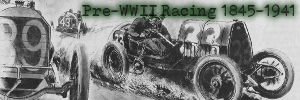















AUTO RACE PILOTS ARE NOT DEVELOPED |
|---|
 Topics: Indianapolis 500
Topics: Indianapolis 500
|
The New York Times
February 5, 1911
INDIANAPOLIS, Ind., Feb. 4.-Where does the automobile race pilot come from? This is the question asked by hundreds of the spectators who see the driver of to-day rush around the great road courses and speedways of the Nation in quest of honor and gold. The answer is seemingly simple, yet with it comes the statement that race drivers are born, not developed, through mere skill and mechanical knowledge.
The average race driver who is seen in the space annihilating monsters which careen wildly over the tracks thinks no more of sending his steel steed along at the death-inviting pace than he would of driving a touring car through the city streets-in many cases not half so much. Two-thirds or more of the racing drivers of to-day were city traffic drivers of yesterday; men who turned on the taximeter when you entered the taxicab at hotel or station, and carried you safely through the crowded streets to your destination.
City traffic driving, and especially taxicab driving, is the training school for the dare devils who thrill thousands with their dashes over the race courses in quest of gain. In Indianapolis now there are fully eight or ten men who are competent to take the biggest speed cars over a race course in competition with the world's greatest pilots and with a marked degree of success.
The greatest drivers of to-day have been traffic and demonstration drivers. Louis Chevrolet drove traffic in New York City for five years. His brother Arthur did the same. Victor Hemery drove traffic in Germany many years before he raced a car. Ralph DePalma was a traffic driver in New York. "Wild Bob" Burman drove a demonstrating car for several years; in fact, almost every great racing pilot has risen from the ranks of the traffic and taxicab driver, rather than from the testing force of any factory.
Most of these drivers and many others will compete in the 500-mile International Sweepstakes race over the Indianapolis Motor Speedway, on Memorial Day, May 30 next. There have been six entries made for the race thus far as follows: Lewis Strang, in a Case car; C. B. Baldwin, in an Inter-State "50"; Johnny Aitken in a National "40"; Frank P. Fox of Indianapolis, in a Pope-Hartford, and Louis Disbrow in the same make of car, the other entry being a Simplex, for which no driver has been named so far. It is possible that Ralph DePalma, the mile track champion of 1910, will pilot this last named car through the long grind.
Many other entries are soon to be made, among them "Wild Bob" Burman and Arthur Chevrolet, in Buick "100" cars; Spencer Wishart, in a Mercedes; Herbert Lytle, in a Napier; Frank T. Dearborn, in a Fiat; W. H. Turner, in an Amplex; Joe Dawson, in a Marmon Special and others.
The purse of $25,000 in gold is proving a magnet for the best drivers in the business, and it is probable before the lists close that the thirty cars which will face the starter, will be manned by the greatest galaxy of pilots ever brought together for one event.
